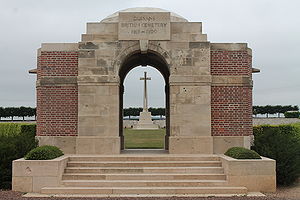Duisans British Cemetery, Etrun
| Duisans British Cemetery | |
|---|---|
 | |
| Country: | France |
| Location: | Pas de Calais |
| Coordinates: | |
| Type: | Public |
| Owned by: | Commonwealth War Graves Commission |
| Number of gravesites: | 3,201 |
| Website: | Duisans British Cemetery |
The Duisans British Cemetery is a cemetery in the Pas de Calais region of France containing the graves of Canadians killed during the Great War.
History
The area around Duisans was occupied by Commonwealth forces from March 1916, but it was not until February 1917 that the site of this cemetery was selected for the 8th Casualty Clearing Station. The first burials took place in March and from the beginning of April the cemetery grew very quickly, with burials being made from the 8th Casualty Clearing Station (until April 1918), the 19th (until March 1918), and the 41st (until July 1917).
Most of the graves relate to the Battles of Arras in 1917, and the trench warfare that followed. From May to August 1918, the cemetery was used by divisions and smaller fighting units for burials from the front line. In the Autumn of 1918 the 23rd, 1st Canadian and 4th Canadian Clearing Stations remained at Duisans for two months, and the 7th was there from November 1918 to November 1920.
There are now 3,207 Commonwealth servicemen of the First World War buried or commemorated at Duisans British Cemetery. There are also 88 German war graves.
Location
Duisans and Etrun are villages in the Department of the Pas-de-Calais, about 9 kilometres west of Arras. The Cemetery lies in Etrun but takes its name from the nearer village of Duisans.
It is one kilometre north of Duisans on the D339 road off the Route nationale N39 (Arras-St Pol), in the angle of the Arras Habarcq road and a track leading to Haute-Avesnes.
"We Rest Here"
The following Signals related people are buried here.
| Headstone | Service Number | Rank and Name | Grave Location |
|---|---|---|---|
| |
541509 | Spr R.S. Bartlett | VIII. A. 3. |
| |
500607 | Sgt C.V. Boyd | VIII. A. 9. |
| |
86016 | Sgt H.L. Buck | VI. H. 26. |